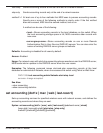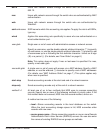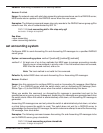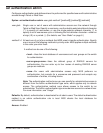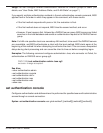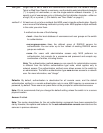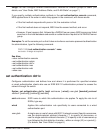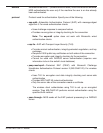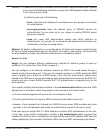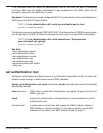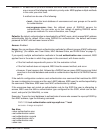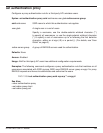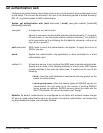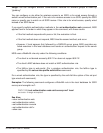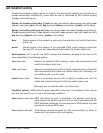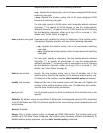
D-Link DWS-1008 CLI Manual 191
method1-4 At least one of up to four methods that MSS uses to handle authentication. Specify
one or more of the following methods in priority order. MSS applies multiple methods
in the order you enter them.
A method can be one of the following:
• local—Uses the local database of usernames and user groups on the switch
for authentication.
• server-group-name—Uses the defined group of RADIUS servers for
authentication. You can enter up to four names of existing RADIUS server
groups as methods.
• none—For users with administrative access only, MSS performs no
authentication, but prompts for a username and password and accepts any
combination of entries, including blanks.
Defaults: By default, authentication is unconfigured for all clients with network access through
AP ports or wired authentication ports on the switch. Connection, authorization, and accounting
are also disabled for these users. Bonded authentication is disabled by default.
Access: Enabled.
Usage: You can configure different authentication methods for different groups of users by
“globbing.” (For details, see “User Globs” on page 6.)
You can configure a rule either for wireless access to an SSID, or for wired access through a
switch’s wired authentication port. If the rule is for wireless access to an SSID, specify the SSID
name or specify any to match on all SSID names. If the rule is for wired access, specify wired
instead of an SSID name. You cannot configure client authentication that uses both the EAP-TLS
protocol and one or more RADIUS servers. EAP-TLS authentication is supported only on the
local database.
If you specify multiple authentication methods in the set authentication dot1x command, MSS
applies them in the order in which they appear in the command, with these results:
• If the first method responds with pass or fail, the evaluation is final.
• If the first method does not respond, MSS tries the second method, and so on.
• However, if local appears first, followed by a RADIUS server group, MSS overrides any failed
searches in the local database and sends an authentication request to the server group.
If the user does not support 802.1X, MSS attempts to perform MAC authentication for the user.
In this case, if the switch’s configuration contains a set authentication mac command that
matches the SSID the user is attempting to access and the user’s MAC address, MSS uses the
method specified by the command. Otherwise, MSS uses local MAC authentication by default.



